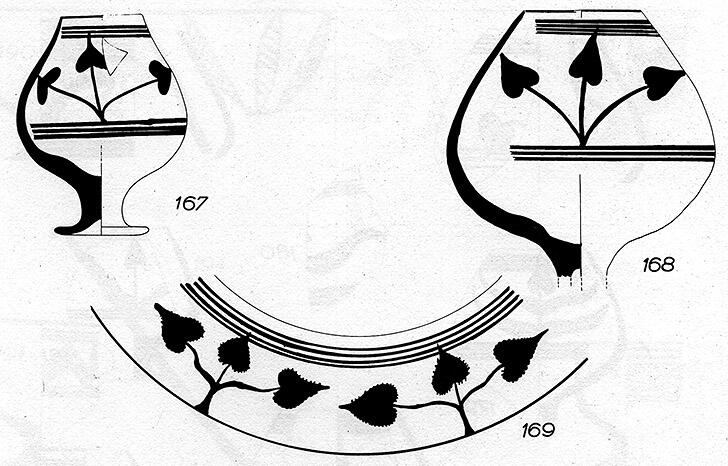"These balloon glasses are characteristic of the urban period [Period IV]. Most often, their decor includes either rows of caprids with an elongated body and hatching in the Iranian style of Susa II, or leaves of the pipal tree so frequent in the decorative repertoire of the Indus civilization" wrote Casal (Archeologia, Nov.-Dec. 1966, p. 37).
"Copper and bronze did not appear at Mundigak before the sixth level, in the form of a long pin with a flattened head pierced by a hole. The layers that followed—still all dwelling houses—showed the continuation of a well-established way of life with the same type of buildings and very little modification. The painted pottery improved considerably at this level and became abundant from the eighth level upwards. From the very beginning the pottery had been buff, and in the seventh level, side by side with naturalistic designs of leaves and so on, appeared pottery with a stepped motif, distinctive of the Quetta-ware. In the eighth level came the first signs of a “brandy balloon”—buff or rose-tan goblets exactly the same shape as present- day brandy glasses, a type of pottery that developed in the next two layers till the goblets were found in all sizes, some painted with ibexes and some with the leaves of the wild fig tree." (Matheson, Time off to Dig, London, 1961, p. 100)
"Other trees may have also been held as sacred," writes Jonathan Mark Kenoyer, "but for over 6,000 years, different cultures of the region have used the pipal tree as an important symbol. Heart-shaped pipal leaves, often arranged in groups of three, were commonly painted on small jars during the Early Harappan period before the rise of Indus cities. We find elaborate paintings of the pipal tree and its wide, spreading branches on large storage jars as well as smaller domestic vessels from the Indus period. Depicted in the Indus script as well as oe faience ornaments and shell inlay, the heart-shaped pipal leaf was reproduced in many contexts and styles throughout the Indus cities." (Ancient Cities of the Indus Valley Civilization, p. 105)
Casal also noted that while "the shape of the tasting glass is generally reserved for a decor of naturalist inspiration borrowed either from the animal kingdom, or from the vegetable kingdom, and each one marks their own affinities. While the treatment of caprids [goats] is reminiscent of that of oxen in Kulli ceramics, the plant motif first evokes the pipal leaves which appear on pottery in the Indus valley." (Quatre campagnes de fouilles à Mundigak, 1951-1954, pp. 171-2)
Jean-Francois Jarrige, Aurore Didier and Gonzague Quivron write in Shahr-i Sokhta and the chronology of the Indo-Iranian regions (2011), "More recently the excavations carried out by S.M.S. Sajjadi in the graveyard of the Shahr-i Sokhta from 1997 to 2000 have revealed a series of tombs dated to Period IV [ 2300-2100 BCE]. Tomb 1705 has provided a bowl decorated inside with stylized pipal leaves arranged in large volumes in the same style as the bowl mentioned above (fig. 12:8), and very similar to the examples from Lal Shah and Nausharo IC [2700-2600 BCE]. Other pipal designs founds on bowls in tomb 1705 (fig. 12:10) are obviously very close to decorations characteristic of the same area in Balochistan (fig 12:9, 11). These significant and complex designs cannot be submitted to fortuitous comparison, unlike the simple geometric motifs" (p. 22).
"Under the staircase a long, narrow room about the size of a small walk-in larder was now appearing. From it we took, one after the other, a series of perfect, buff-ware drinking vessels and goblets, as good as the day they left the potter’s wheel, and I tried to imagine that a housewife of long ago, storing her precious drinking vessels so carefully that four or five thousand years later I could find them just as she had left them." (Matheson, Time off to Dig, London, 1961, pp. 95-6)
Image 2: Top portion of Figures Ceramic from Period IV [2900-2400 BCE] from Casal, Fouilles De Mundigak [Excavations at Mundigak], 1961.




